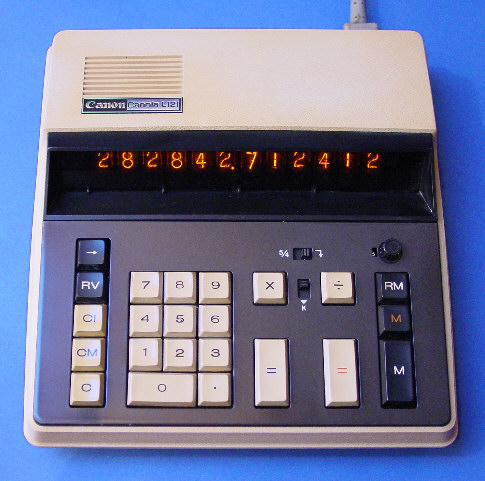
DATAMATH CALCULATOR MUSEUM
 |
DATAMATH CALCULATOR MUSEUM |
Canon Canola L121
| Date of introduction: | 1971 | Display technology: | Nixie |
| New price: | Display size: | 12 | |
| Size: | 9.7" x 9.1" x 2.6" | ||
| Weight: | 4 pounds 9 ounces | Serial No: | 411309 |
| Batteries: | n.a. | Date of manufacture: | year 1971 |
| AC-Adapter: | 220V | Origin of manufacture: | Japan |
| Precision: | 12 | Integrated circuits: | TMC1733, TMC1753, TMC1754, TMC1807 |
| Memories: | 1 | ||
| Program steps: | Courtesy of: | Joerg Woerner |
 The
Canon Canola L121 represents the first desktop calculator using Large-Scale-Integrated (LSI)
circuits and was available in 1971.
The
Canon Canola L121 represents the first desktop calculator using Large-Scale-Integrated (LSI)
circuits and was available in 1971.
 From the technical view the L121 is from
great interest, it
uses the TMC1733, TMC1753, TMC1754, TMC1755 (or TMC1807) calculator chip set developed by Texas Instruments.
The chip numbers imply that the L121 followed immediately the famous Pocketronic
with the three
TMC1730, TMC1731, TMC1732 LSI circuits.
From the technical view the L121 is from
great interest, it
uses the TMC1733, TMC1753, TMC1754, TMC1755 (or TMC1807) calculator chip set developed by Texas Instruments.
The chip numbers imply that the L121 followed immediately the famous Pocketronic
with the three
TMC1730, TMC1731, TMC1732 LSI circuits.
Each of the four chips provide a specific functional part
of the logic of the machine.
| Data Chip (TMC1733) contains the majority of the working registers of the machine, logic for routing and some processing of data as it is routed between the various registers, and some Nixie display decoding/multiplexing logic. | |
| Timing Chip (TMC1753) provides for controlling and coordinating the operations of the calculator, as well as providing for some miscellaneous functions such as keeping track of decimal point location. | |
| Entry Chip (TMC1754) provides the logic for handling the input from the keyboard. It takes care of key debouncing, locking the keyboard when errors exist, keyboard encoding, and other input-related functions. | |
| Arithmetic Chip (TMC1807, apparently an updated version of the TMC1755 mentioned in the service manual for the machine) contains the logic that actually performs arithmetic operations. | |
| The already mentioned Pocketronic used an unique
thermal printer to display the calculating results. Why ? The LED Display (Light-Emitting-Diode) wasn't yet developed and the already developed Nixie tubes huge and running on high voltages. |
 |
| One of the 12 Nixie tubes in action. Each numeral is a complete, lighted cathode in the shape of the numeral. The cathodes are stacked so that different numerals appear at different depths to the viewer. The anode is a transparent metal mesh wrapped around the front of the display. The tube is filled with the inert gas neon with a small amount of mercury. When about 180 volts DC is applied between the anode and one of the ten cathodes, the gas near the cathode breaks down and glows with a warm orange color. |  |
| Type | Year | Digits | Display technology | Chip set |
| L121 | 1971 | 12 | Nixie tubes | TMC1733, TMC1753, TMC1754, TMC1807 |
| L100 | 1971 | 10 | Panaplex
style single tubes |
TMC1737, TMC1753, TMC1754, TMC1807 |
| L100A | 1971 | 10 | Panaplex style | TMS1824, TMS1825 |
| L100S | 1972 | 10 | Panaplex style | TMS0106 single chip |
| L121F | 1972 | 12 | Panaplex style | TMS0201, TMS0302 |
The Canola 121F is the direct
successor of this L121 adding a Constant key and a more advanced memory
operation.
If you have additions to the above article please email: joerg@datamath.org.
© Rick Bensene and Joerg Woerner, December 21, 2002. No reprints without written permission.